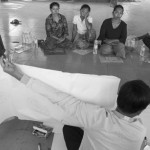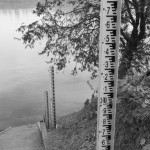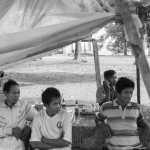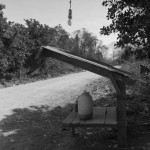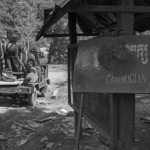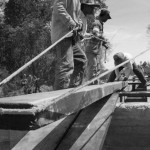Three Rivers Dams (7)
The village of Kahchen is the former Governor of Ratanakkiri’s turf. He is an indigenous Tampuon. He builds a nice big house, painted a shiny light blue, near the centre of the village. He was recently replaced by someone closer to the central power and who is not a Tampuon. Most of the villagers in Kahchen are Tampuon.
The former Governor ‘gave’ the villagers a beautifull space in the middle of the village, shadowed by huge trees, dotted with three buildings. One, airy, made of brick and concrete allows for a peacefull contemplation of the Sesan river or training sessions for farmers organised by an NGO. The second, on stilts, in wood, is where the monthly community meetings take place. Matters strictly Tampuon are discussed there, sometimes quite vehemently. No press allowed. A third construction, much smaller, is some kind of a weather station. It is built next to a gate and a set of stairs leading down to the river. Five measuring sticks are lined up along the stairs, for a total height of 12 meters. That is how high the Sesan river can reach during the rainy season. But when the Yali dam in Vietnam has to let go of an excess of water the Sesan can rise beyond those 12 meters.
The community has experienced it several times already. That might be one of the reasons they oppose the construction of dams on the Sesan. But they also know about the consequences the Three Rivers Dams will inflict on their community: depleting fish stocks, possible relocation, loss of valuable agricultural land along the river banks… What probably troubles them most is that no one higher up seems to read the letters they sent out expressing their concerns. They get frustrated: no one with responsibility seems to listen, there is not enough feedback. It’s not because they are Tampuon that they don’t want electricity. Of course they want it. But they want to have electricity and remain Tampuon. And they don’t see it happen.
